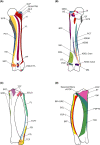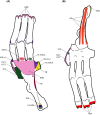Myology of the pelvic limb of the brown-throated three-toed sloth (Bradypus variegatus)
- PMID: 35037260
- PMCID: PMC9119613
- DOI: 10.1111/joa.13626
Myology of the pelvic limb of the brown-throated three-toed sloth (Bradypus variegatus)
Abstract
Tree sloths rely on their limb flexors for bodyweight support and joint stability during suspensory locomotion and posture. This study aims to describe the myology of three-toed sloths and identify limb muscle traits that indicate modification for suspensorial habit. The pelvic limbs of the brown-throated three-toed sloth (Bradypus variegatus) were dissected, muscle belly mass was recorded, and the structural arrangements of the muscles were documented and compared with the available myological accounts for sloths. Overall, the limb musculature is simplified by containing muscles with generally long and parallel fascicles. A number of specific and informative muscle traits are additionally observed in the pelvic limb of B. variegatus: well-developed hip flexors and hip extensors each displaying several fused bellies; massive knee flexors; two heads of the m. adductor longus and m. gracilis; robust digital flexors and flexor tendons; m. tibialis cranialis muscle complex originating from the tibia and fibula and containing a modified m. extensor digitorum I longus; appreciable muscle mass devoted to ankle flexion and hindfoot supination; only m. extensor digitorum brevis acts to extend the digits. Collectively, the findings for tree sloths emphasize muscle mass and organization for suspensory support namely by the hip flexors, knee flexors, and limb adductors, for which the latter two groups may stabilize suspensory postures by exerting appreciable medially-directed force on the substrate. Specializations in the distal limb are also apparent for sustained purchase of the substrate by forceful digital flexion coupled with strong ankle flexion and supination of the hind feet, which is permitted by the reorganization of several digital extensors. Moreover, the reduction or loss of other digital flexor and ab-adductor muscles marks a dramatic simplification of the intrinsic foot musculature in B. variegatus, the extent to which varies across extant species of two- and three-toed tree sloths and likely is related to substrate preference/use.
Keywords: flexors; hindlimb; mass; muscle; suspension; suspensory support.
© 2022 Anatomical Society.
Figures










Similar articles
-
Pump the brakes! The hindlimbs of three-toed sloths decelerate and support suspensory locomotion.J Exp Biol. 2023 Apr 15;226(8):jeb245622. doi: 10.1242/jeb.245622. Epub 2023 Apr 19. J Exp Biol. 2023. PMID: 36942880 Free PMC article.
-
Muscle architectural properties indicate a primary role in support for the pelvic limb of three-toed sloths (Bradypus variegatus).J Anat. 2023 Sep;243(3):448-466. doi: 10.1111/joa.13884. Epub 2023 May 15. J Anat. 2023. PMID: 37190673 Free PMC article.
-
Three-Dimensional Limb Kinematics in Brown-Throated Three-Toed Sloths (Bradypus variegatus) During Suspensory Quadrupedal Locomotion.J Exp Zool A Ecol Integr Physiol. 2025 Jun;343(5):564-577. doi: 10.1002/jez.2911. Epub 2025 Mar 3. J Exp Zool A Ecol Integr Physiol. 2025. PMID: 40033687 Free PMC article.
-
IDLY INFECTED: A REVIEW OF INFECTIOUS AGENTS IN POPULATIONS OF TWO- AND THREE-TOED SLOTHS (CHOLOEPUS SPECIES AND BRADYPUS SPECIES).J Zoo Wildl Med. 2021 Jan;51(4):789-798. doi: 10.1638/2018-0188. J Zoo Wildl Med. 2021. PMID: 33480559 Review.
-
The role of sloths and anteaters as Leishmania spp. reservoirs: a review and a newly described natural infection of Leishmania mexicana in the northern anteater.Parasitol Res. 2019 Apr;118(4):1095-1101. doi: 10.1007/s00436-019-06253-6. Epub 2019 Feb 15. Parasitol Res. 2019. PMID: 30770980 Review.
Cited by
-
Pump the brakes! The hindlimbs of three-toed sloths decelerate and support suspensory locomotion.J Exp Biol. 2023 Apr 15;226(8):jeb245622. doi: 10.1242/jeb.245622. Epub 2023 Apr 19. J Exp Biol. 2023. PMID: 36942880 Free PMC article.
-
Muscle architectural properties indicate a primary role in support for the pelvic limb of three-toed sloths (Bradypus variegatus).J Anat. 2023 Sep;243(3):448-466. doi: 10.1111/joa.13884. Epub 2023 May 15. J Anat. 2023. PMID: 37190673 Free PMC article.
References
-
- Alexander, R.M. (1991) Elastic mechanisms in primate locomotion. Zeitschrift für Morphologie und Anthropologie, 78(3), 315–320. - PubMed
-
- Carillo, E. , Fuller, T.K. & Saenz, J.C. (2009) Jaguar (Panthera onca) hunting activity: effects of prey distribution and availability. Journal of Tropical Ecology, 25, 563–567.
-
- Cartmill, M. (1985) Climbing. In: Hildebrand, M. , Bramble, D.M. , Liem, K.F. & Wake, D.B. (Eds.) Functional vertebrate morphology. Cambridge: The Belknap Press of Harvard University Press, pp. 73–88.
-
- Chiarello, A.G. (2008) Sloth ecology: an overview of field studies. In: Vizcaíno, S.F. & Loughry, W.J. (Eds.) The biology of the xenarthra. Gainesville: University Press of Florida, pp. 269–280.
Publication types
MeSH terms
LinkOut - more resources
Full Text Sources

